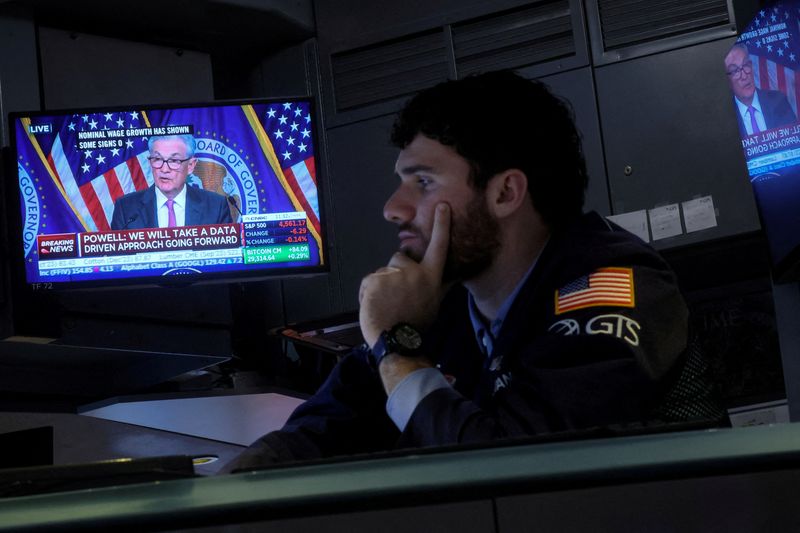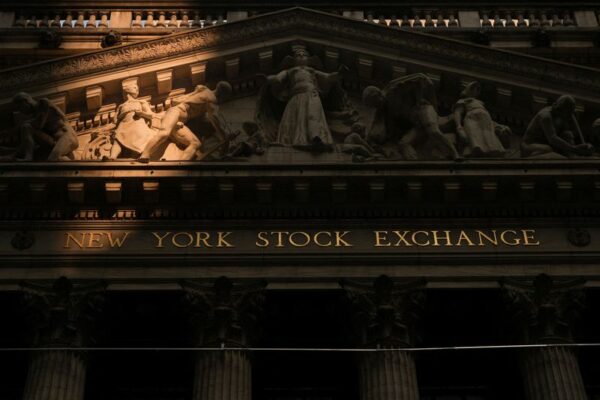Jumping yields, slumping stocks may boost case for a Fed pause
By Howard Schneider
WASHINGTON (Reuters) - Rising Treasury bond yields and home mortgage rates may reduce support at the U.S. Federal Reserve for additional interest rate increases, the prospect of which have already been ebbing on the basis of weaker inflation.
The Fed raised interest rates at its July meeting by a quarter of a percentage point, to a range of between 5.25% and 5.5%, a widely anticipated move investors have construed as the central bank's last step in an aggressive 16-month rate hike campaign to slow inflation from 40-year highs.
But bond yields since then have raced higher, with the interest rate on a 10-year U.S. Treasury security rising from around 3.86% the day of the Fed's July 26 rate decision to as high as 4.32% on Thursday.
Rates on a 30-year home mortgage in the U.S. rose to 7.09%, breaching the 7% level for the first time since November and marking a more than 20-year high.
Stock markets - which can offer investors higher returns but also higher risk versus less volatile assets like Treasury bonds - have declined, with the S&P 500 reversing a five-month climb to fall about 2.6% since the Fed's last meeting.
Investors in contracts tied to the Fed's benchmark interest rate added to bets that it will move no higher, a view shared by 99 of 110 economists polled by Reuters this week who also see the risk of a U.S. recession in decline.
The recent climb in yields has been fast enough and surprising enough that "the Fed will be monitoring bond market developments - and the wider fall-out across asset markets - carefully," said Evercore ISI vice chair Krishna Guha.
The Fed watches an array of asset prices in its monitoring of the economy, including stocks, home prices, and corporate bonds.
"A rise in yields on this scale represents a serious tightening of financial conditions in the Fed's standard framework," enough so that the Fed will want to "avoid piling on" with further tightening of its own, said Guha, a former official at the New York Fed.
For the Fed, the rising yields may help resolve an issue that has preoccupied policymakers in recent months: whether financial markets and the economy had fully adapted to the rate increases it has imposed since last year, or whether there was still a tightening of market-based borrowing costs yet to come.
Indeed, many Fed officials have puzzled over a recent easing of financial conditions, with equity markets rising and some home price indexes moving up despite the Fed's own rate increases and hawkish rhetoric that rates will stay high for as long as it takes to be sure inflation returns to the central bank's 2% target.
A new Fed financial conditions index has been falling since December, and some policymakers have cited higher home values and other factors as evidence monetary policy was not having as much impact on the economy as expected, and that rates might need to move higher still.
As of the Fed's July meeting, most Fed officials said they thought rates would need to increase more, with key measures of inflation still more than double the Fed's 2% target.
Overall economic growth also has continued to outperform expectations, with a strong July retail sales report the latest example of the economy's surprising strength - representing another conundrum for policymakers who both expect the economy to slow and feel it must for inflation to continue falling.
Normally, Fed officials would be expected to see that sort of economic strength as a reason inflation might stay high and require further rate increases.
But if the rise in yields is sustained, that may show the bond market increasing borrowing costs and slowing the economy on its own, in line with what policymakers have been expecting to happen.
In the end, how the Fed balances those two interpretations will likely hinge on whether upcoming data shows inflation continuing to ease while job and wage growth slows towards pre-pandemic levels.
"It may take sustained higher 10-year yields to slow the economy and the housing sector in particular to re-attain 2% target inflation," wrote economists from Citi.












 Bitcoin
Bitcoin  Ethereum
Ethereum  XRP
XRP  Tether
Tether  Solana
Solana  USDC
USDC  Lido Staked Ether
Lido Staked Ether  Dogecoin
Dogecoin  TRON
TRON